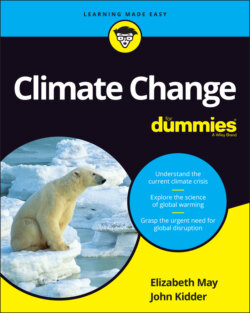Читать книгу Climate Change For Dummies - Elizabeth May - Страница 42
Looking at the carbon cycle
ОглавлениеCarbon dioxide occurs naturally — in fact, you, and every animal and insect on Earth that breathes in air, produce carbon dioxide every time you exhale. You inhale oxygen (and other gases), which your body uses as a nutrient, and you breathe out what your body doesn’t need, including carbon dioxide. You aren’t alone in using this process. But other organisms, mostly plants, suck carbon dioxide out of the air. Trees and grasses, for example, take in carbon dioxide and give out oxygen — the complete opposite of what people do.
The carbon cycle is the natural system that, ideally, creates a balance between carbon emitters (such as humans) and carbon absorbers (such as trees), so the atmosphere doesn’t contain an increasing amount of carbon dioxide. It’s a huge process that involves oceans, land, and air. Life as humans know it — from microscopic bugs in the oceans to you and me, and every fern and plant in between — would disappear without this cycle. You can think of the carbon cycle almost as the Earth breathing in and out.
The carbon cycle is called in balance when roughly the same amount of carbon that’s being pumped into the air is being sucked out by something else. The atmospheric concentration of carbon dioxide was historically at a concentration of 280 ppm — carbon dioxide concentrations have fluctuated up and down through natural processes, but 280 ppm has been about the highest recorded concentration for the past 800,000 years — until recently when humans started to increase the concentration. (We look at how humans contribute carbon dioxide to the atmosphere in Part 2.)
